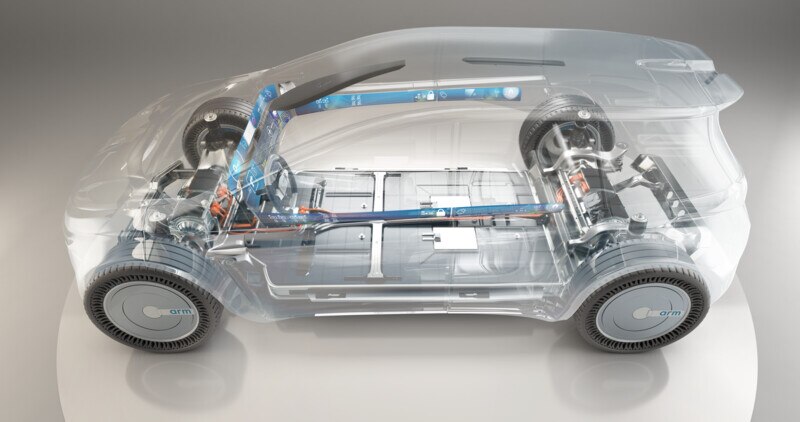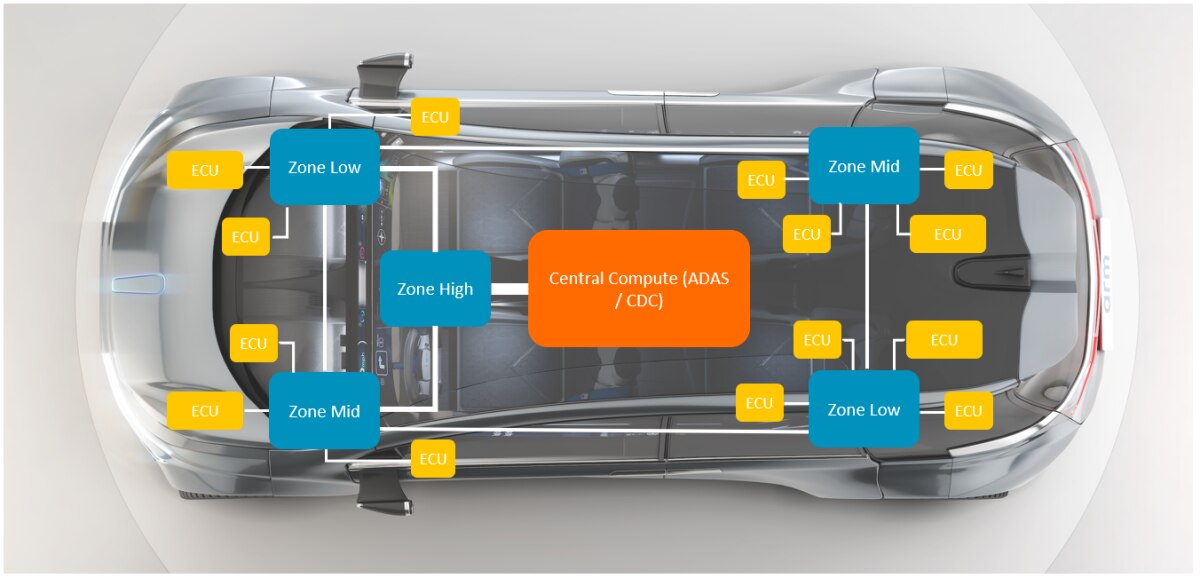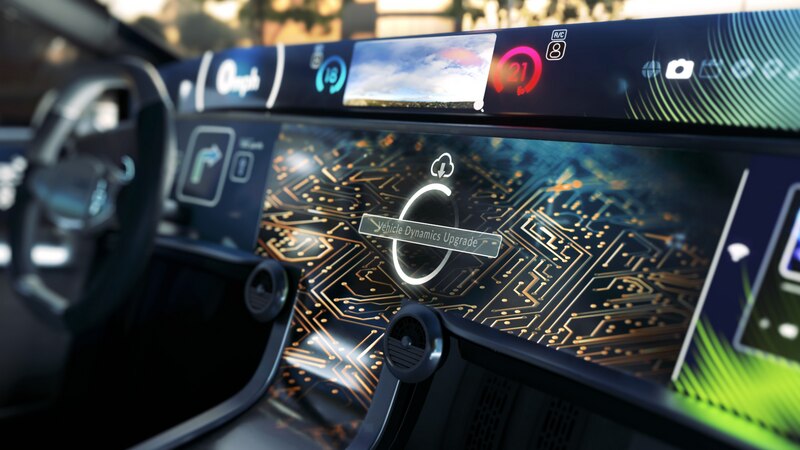“No Controller Left Behind”: Why Cortex-M CPUs are the Automotive Choice for Microcontrollers

The automotive sector is undergoing an unparalleled transformation, as the industry embraces the new era of software defined vehicles (SDVs) and addresses the challenges in security of supply. This is leading to the evolution of computing architecture and the supply chain across the industry.
The core compute components
The compute platform of SDVs consists of three core components. Central compute for ADAS (advanced-driver assistance systems) to enable greater driver autonomy and general vehicle compute functions. Multiple zonal controllers serve as hubs for power distribution and data connection, as well as supporting various real-time automotive functions (see my colleague Bernhard Rill’s article for more information). And, finally, there are many more endpoint microcontrollers (MCUs) integrated into Electronic Control Units (ECUs) to support single function operations across the compute platform, including sensors, actuation and hardware control.

MCUs that adopt Arm’s Cortex-M CPUs are set to play a defining role in automotive compute platforms where “no controller is left behind.” These MCUs will offer the capabilities, power, scalability and common architecture to support the computing transformation in the automotive industry.
The software defined vehicle
Before delving into the role of MCUs and Cortex-M CPUs, it is important to reflect on what determines an SDV. As my colleague Robert Day wrote previously, SDVs will deliver software updates across the car similar to those that are regularly deployed on today’s smartphones. These could be notifications of updates to the system or enhancements to the vehicle that are possibly requested by the driver. For example, the steering system may be upgraded for more responsive ‘sporty’ handling, new functionality could be added to the ADAS for more driving aids or the battery management system could be upgraded to offer an increase in the vehicle’s range. In order to enable these updates, SDVs will also need a cloud-native environment where software will be created and tested in the cloud before it is deployed in the vehicle.

The rise of MCUs
Although the EE architectures of new vehicles are being centralized, the volume and capabilities of MCUs are set to expand across the automotive industry. According to analysis by Strategy Analytics, between 2021 and 2026 the number of MCUs is set to rise by around 8 percent outstripping growth in vehicle production. These MCUs will be the enablers of remote edge sensing points, controlling specific operations within the vehicle with low power and high efficiency, and fit within the new software architecture of SDVs.
The growth of MCU capabilities and compute power has continued over multiple generations. MCUs have moved from 8-bit to 16-bit and then onto 32-bit as requirements continue to expand. In fact, many of the smallest of nodes continue to develop and migrate to 32-bit controllers, with Arm’s automotive partners committing to new 32-bit products in 2023 (stay tuned for more announcements on this in the future).
With over-the-air (OTA) updates happening throughout the lifetime of future SDVs, MCUs need to continually offer a trustworthy execution environment with enhanced security features to prevent malicious software making illegal access to important information, such as privacy, legal or financial, or causing potentially fatal accidents. Functional safety is also of paramount importance in vehicles. This has never been more true than in the endpoint MCUs where critical measurements and actuation may be taking place, meaning these MCUs must adopt functional safety features.
The role of Cortex-M
Arm’s Cortex-M CPUs deliver the features that are needed for MCUs in the automotive compute platforms of the future. Automotive partners – like Elmos Semiconductor which plans to adopt a range of Cortex-M products in its next-generation of automotive MCUs – are choosing Cortex-M for their MCUs as the product range delivers a common architecture, functional safety, advanced security and a broad ecosystem of support.

A common architecture
Recent global supply limitations have impacted the automotive industry. In some cases, vehicles have been unable to ship due to the lack of availability of endpoint MCUs. With few options for alternative controllers, vehicles have been stockpiled awaiting the availability of these critical components. The deployment of a standardized MCU compute architecture assists in providing added flexibility to deploy alternative products to fill gaps in availability.
Through 30 years of working with automotive industry partners, Arm has a diverse and scalable portfolio of compute cores for a variety of automotive applications, from the high-performance central compute to power-efficient endpoint MCUs. This provides a common architecture that means designers and developers benefit from scalable hardware and software that can be used across these automotive applications, saving engineering time and costs. Looking ahead to new SDVs, having this common architecture will enable software development and deployment, and OTA updates.
Functional safety
Functional safety underpins safety critical applications in automotive systems, helping to minimize the risk to people and the environment by detecting and reporting faults that may result in hazardous conditions. Functional safety is increasingly important as new technologies like autonomous driving emerge, while also continuing to support already established safety critical needs. Its need also extends to other markets beyond automotive, such as industrial, aerospace and transportation.
The Cortex-M family brings safety capabilities across all performance points of embedded controllers, enabling Arm’s partners to develop safety critical systems that scale. Cortex-M85, Cortex-M55 and Cortex-M23 have a multitude of safety features that partners can utilize to achieve their safety goals in an efficient way.
Support from a broad software ecosystem then provides a plethora of safety certified software and tools for safety critical developments built on Arm Cortex-M CPUs. These can be easily accessed by Arm’s partners and the wider developer community. Arm also provides native support for safety tools and software, such as Arm’s functional safety run-time system (FuSa RTS), Software Test Libraries and Arm Compiler for Embedded.

Security
Like safety, there is a rising need for enhanced cybersecurity to guard against malicious software attacks that pose serious threats to passenger vehicles. A hack now pose significant safety concerns, particularly as levels of autonomy rise in vehicles. Security features are also needed to protect against unauthorized access to information. Upstream’s 2022 Global Automotive Cybersecurity Report states that 87.7 percent of reported security incidents in 2020 and 2021 were caused by threats to vehicle data and code.
The attack surface has increased in connected SDVs, with security needing to be considered across the complete vehicle and not just the high-performance nodes. The protection of edge MCUs must be accounted for and, together with the rest of the vehicle, considered across the lifetime of the vehicle to include software updates.
At a processor level, this means being able to trust the code being executed and having security features to mitigate spurious software attacks. Cortex-M class CPUs are increasingly used to perform secure system management and boot management services in central and zonal compute architectures. Through the Armv8-M architecture, TrustZone is introduced across the Cortex-M family. Cortex-M23 and Cortex-M33 are the first processors to support the hardware enforced separation and security offered by TrustZone. This ensures system-wide security spanning software, CPUs, Interconnect, Memory and Peripherals.
Through the Armv8.1-M architecture, more enhanced security features have also been added. Cortex-M85 includes Pointer Authentication Code (PAC) and Branch Target Indicator (BTI). PAC and BTI help mitigate against return-orientated and jump-orientated software attacks. For more information, read Alan Mujumdar’s blog on the Armv8.1-M PAC and BTI extension.

The Arm ecosystem
As SDVs continue to play a more prominent role in the automotive sector, Tier 1s, OEMs and developers are looking at ways to optimize time and costs for software development. The sheer scale of the Arm architecture – with more than 200 billion deployments to date – motivates providers of tools, operating systems and software libraries to add Arm support in their offerings, enabling cost-effective software development. For Cortex-M processors, Arm’s ecosystem partners offer a broad range of support for IDE, compilers, Debug and Trace tools and software. Arm also offers the Common Microcontroller Software Interface Standard (CMSIS) that provides consistent and standardized software building blocks. All this means automotive developers can choose from a broad range of options to reduce their time-to-market and development risk.
Driving automotive growth
The compute requirements of new SDVs support the wider automotive industry’s continuing need for a multitude of MCUs in vehicle compute platforms, with “no controller left behind.” Cortex-M CPUs offer power efficient computing, scalability, safety features and security functionality to support this drive towards wider MCU adoption. Alongside the product capabilities, Arm has the world’s largest software ecosystem that provides wider support to deliver a seamless integration and developer experience. With Cortex-M based MCUs helping to drive the growth of new vehicles like SDVs, the future of the automotive sector will be one that is built on Arm.
Cortex-M in automotive MCUs
Cortex-M CPUs are driving new MCU capabilities in new automotive vehicles like SDVs.
Any re-use permitted for informational and non-commercial or personal use only.













